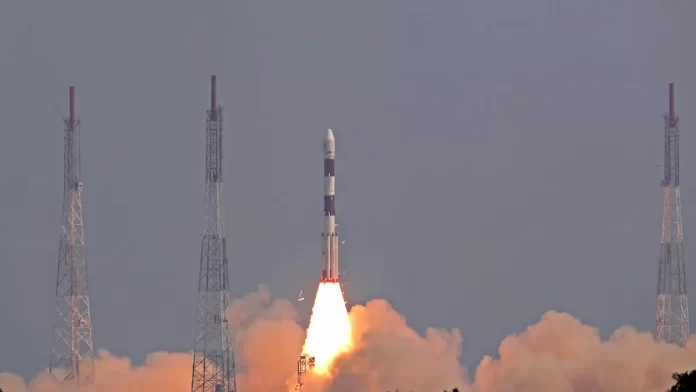PM Narendra Modi on Saturday congratulated ISRO and NSIL on the successful launch of the PSLV C54 mission.
The third generation Indian satellite for monitoring the oceans, formally named as Earth Observation Satellite-6 (EOS-6) was launched by the Indian Space Research Organization (ISRO) in partnership with Ministry of Earth Sciences (MoES) among others, from its First Launch Pad (FLP) at Satish Dhawan Space Centre (SDSC), Sriharikota.
The ocean observing mission is a follow up to OceanSat-1 or IRS-P4 and OceanSat-2 launched in 1999 and 2009, respectively.
The satellite was launched aboard the proven launch vehicle PSLV (Polar Satellite Launch Vehicle) on its 56th flight (24th flight of the PSLV-XL version).
Today’s launch, designed as PSLV-C54, also accommodated other small satellites along with Oceansat-3.
Oceansat-3 Satellite
The Oceansat-3 was placed in the polar orbit at the height of about 740 kilometers above sea level. While at ~1100 kilograms, it is only slightly heavier than Oceansat-1, for the first time in this series it houses three ocean observing sensors viz Ocean Color Monitor (OCM-3), Sea Surface Temperature Monitor (SSTM), and Ku-Band scatterometer (SCAT-3). There is also an ARGOS payload. All these sensors have their own importance for India’s blue economy aspirations.
The advance 13 channel OCM with 360 m spatial resolution and 1400 km swath will observe the day side of the earth every day and will provide crucial data on distribution of ocean algae which is the base of the food chain within marine ecosystem.
The OCM-3 with high signal-to-noise ratio is expected to provide improved accuracy in daily monitoring of phytoplankton having wide range of operational and research applications including fishery resource management, ocean carbon uptake, harmful algal bloom alerts, and climate studies.
The SSTM will provide ocean surface temperature which is a critical ocean parameter to provide various forecasts ranging from fish aggregation to cyclone genesis and movement.
Temperature is a key parameter required to monitor health of the coral reefs, and if needed, to provide coral bleaching alerts.
The Ku-Band Pencil beam scatterometer onboard EOS-6 will provide high resolution wind vector (speed and direction) at the ocean surface, something which any seafarer would like to know of, whether its fishermen or shipping company.
The data of temperature and wind is also very important for assimilation into ocean and weather models to improve their forecast accuracies.
ARGOS is a communication payload jointly developed with France and it is used for low-power (energy-efficient) communications including marine robotic floats (Argo floats), fish-tags, drifters, and distress alert devices useful for conducting effective search and rescue operations.
Union Minister of State (Independent Charge) Science & Technology; Minister of State (Independent Charge) Earth Sciences; MoS PMO, Personnel, Public Grievances, Pensions, Atomic Energy and Space, Dr Jitendra Singh in a message from Jammu congratulated and thanked ISRO and MoES teams for successful launch.
The Minister said, while ISRO will continue to maintain the orbit of the satellite and its standard procedures for data reception, archive etc the major operational user of this satellite would be MoES institutions viz Indian National Centre for Ocean Information Services (INCOIS), Hyderabad and National Centre for Medium Range Weather Forecasting (NCMRWF), Noida that provide a bouquet of services every day for lakhs of stakeholders across the nation.
Dr Jitendra Singh noted that for this purpose, INCOIS has also established a state-of-the-art satellite data reception ground station within its campus with the technical support of National Remote Sensing Centre (ISRO-NRSC), Hyderabad. He also asserted that ocean observations such as this will serve as strong foundation for the India’s blue economy and polar region policies.
Dr. M. Ravichandran, Secretary, MoES, in congratulatory note to ISRO said, the launch of Oceansat-3 today is also significant since this is the first major ocean satellite launch coming from India since the initiation of the UN Decade of Ocean Science for Sustainable Development (UNDOSSD, 2021-2030).
He said, this satellite will have the capability to make concurrent measurements of Ocean Colour, SST and Sea Surface Winds, and is expected to provide a great boost to the ocean observing capabilities of the global scientific and operational communities in addressing the Ocean Decade objectives and challenges.
